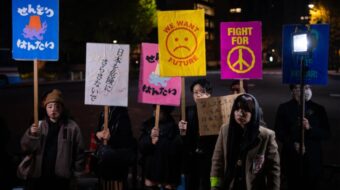The recent decision by the Obama Administration to sell $5.8 billion in arms to Taiwan is a bit of a head scratcher, rather like the hunter who goes into the woods with one bullet. Seeing a deer to his left and a turkey to his right, he shoots in the middle. It will annoy Taipei, irritate Beijing, stir up the China bashers in the U.S., and increase tensions in a region of the world that is already pretty tense.
So what’s the point here?
The plan would upgrade Taiwan’s 140 U.S.-made F-16 A/B jet fighters, plus supply Taipei with Blackhawk helicopters and anti-ballistic missiles. The Obama administration has more than doubled the Bush administration’s arms sales to Taiwan, and this sale would bring that figure to slightly more than $12 billion.
Taipei had asked to buy 66 new F-16 C/Ds, but the White House turned that down, annoying the Taiwanese. “These years, China is showing stronger and stronger reaction to U.S.-Taiwan arms sales,” complained Taipei’s deputy defense minister Andrew Yang, and that has turned Americans “more wary with arms sales.”
While PRC Foreign Ministry spokesman Hong Lei said Beijing “firmly opposes the U.S. arms sales to Taiwan,” China’s reaction was generally low key, certainly more so than when a similar arms sales went through in 2008. Then Beijing canceled joint military consultation with the U.S. and put capitol-to-capitol relations into a deep freeze for many months. After a similar arms sale in 2010, Chinese military leaders went as far as to suggest that China cash in some of American’s $1.1 trillion debt to Beijing.
While the White House can’t get bi-partisan agreement on the budget, it brought Republicans and Democrats together on this issue. Sen. Robert Menendez (D-NJ) and Sen. John Cornyn (R-Tx) have joined hands to introduce legislation demanding that the administration sell the new F-16s to Taiwan. The Taiwan Air Modernization Act cites the 1979 Taiwan Relations Act, which calls for providing defensive weapons to Taipei and resisting any effort by the PRC to forcibly reunite Taiwan with the mainland.
Cornyn thundered that the decision to upgrade rather than sell was “capitulation to Communist China” and a “slap in the face to a strong ally and a long-time friend.” In language straight out of the Cold War, a Coryn-Menendez letter to Obama-signed by 13 Democrats and 23 Republicans-warned that a failure to sell the new fighter aircraft means “Taiwan will be dangerously exposed to Chinese military threats, aggression and provocation, which pose significant security implications for the United States.”
A similar letter, signed by 181 House members, also demanded that Washington approve the sales of new F-16s.
Tucked in amidst the “red dragon” scare rhetoric is pork: “We are deeply concerned that further delay of the decision to sell F-16s to Taiwan could result in closure of the F-16 production line,” the letter argues. Lockheed Martin, maker of the aircraft, has a plant in Cornyn’s Texas, and the company employs 750 workers in Menendez’s New Jersey. The company is the largest arms manufacturer in the world and has a formidable lobbying presence in Washington.
In many ways the whole matter seems mired in the past, particularly the letter’s warning that Taiwan risked losing its “qualitative advantage in defensive arms.” Taipei has not had a “qualitative advantage” over the PRC in any category for the past two decades. Even the Taipei Times writes that “Taiwan would have at most only a few days to hold off China and get help from the outside, most likely the U.S., if they were going to stand any chance.”
According to the Pentagon, the PRC’s fighter aircraft fleet outnumbers Taiwan’s 1,680 to 388, and many of the latter’s planes are obsolete. Besides the 140 F-16 A/Bs, Taipei’s forces include 1970 vintage F-4 Phantoms (an excellent fighter-bomber in its day, but that day is long past), 60 aging French Mirage 2000s (vintage 1982), and 130 domestically produced, but underpowered, Indigenous Defensive Fighter, the “Ching-Kuo.”
The PRC’s fleet features Sukhoi-27 and Sukhoi-30-the latter a match for the U.S.’s premier fighter, the F-15-and China’s domestic fighter, the J-10. A J-20 stealth fighter is in the testing phase but will not be deployed until 2017. Upgrading the F-16s, or even selling Taiwan new ones, will not alter this balance.
The PRC maintains that Taiwan is part of China (and virtually no country in the world, including the U.S., disagrees) and reserves the right to use military force if Taipei tries to establish independence. But “reserves the right” is very different than ramping up the landing craft. Indeed, China has carefully lowered nationalist rhetoric around Taiwan and cross-straits ties are warmer than they were three years ago.
Current Chinese President Hu Jintao has pushed rapprochement with Taipei, but as the Financial Times points out, “his approach to Taiwan is not uncontested within the Chinese Communist Party,” and it notes that “the Party is also preparing to elect a new generation of leaders next year.” That new generation tends to be more nationalistic than the older generation.
The PRC’s armed forces mirror currents in the Communist Party, with a wing that advocates a more assertive role-at least in local waters like the Taiwan Straits and South China Sea-and a more cautious wing that wants to avoid a confrontation with the U.S.
Similar currents exist within the U.S. military establishment, although the Pentagon’s “caution” wing has recently gone silent because of all the talk about cutting military spending. Much of the recent “China threat” talk is aimed at derailing efforts to cut the huge military budget, and, to that end, generals and admirals have closed ranks behind “the dragon is coming, the dragon is coming” gang. One suspects the American hawks have counterparts among the Chinese chiefs of staff.
The arms deal will make President’s Hu’s job more difficult, although he will probably portray the F-16 upgrade as a compromise. Of course, all bets are off if Congress throws a monkey wrench into the deal and insists on new aircraft that won’t change the military balance, but will worsen an already charged diplomatic atmosphere.
The White House is nervous about January elections in Taiwan, which will pit the nationalist Kuomintang Party against the more independence-minded Democratic Progressive Party (DPP). The DPP’s leader, Tsai Ing-Wen, apparently had a recent falling out with Obama administration officials over the independence issue. One U.S. official told the Financial Times, “that while she [Tsai] understood the need ‘to avoid gratuitous provocations’ of China, it was ‘far from clear…that she and her advisors fully appreciate the depth of [Chinese] mistrust of her motives and DPP aspirations.'”
DPP leader Chen Shui-bian, Taiwan’s president from 2000 to 2008 pushed for formal independence and cut off formal negotiations with Beijing during his administration.
If this all seems like a terrible muddle, that’s because it is.
On one hand Washington insists on a robust military presence on China’s doorstep, and continues to supply arms to Taiwan. These are not minor matters. If there is a confrontation between Taiwan and the PRC, and it pulls in the Americans, it will pit two nuclear powers against one another.
The growth of the Chinese navy-Beijing got its first aircraft carrier this year, albeit one half the size of a U.S. flat top-is being portrayed in Washington as a threat to U.S. naval power in the Pacific and Indian oceans. But the PRC’s buildup is about protecting its oil and gas supplies-80 percent travel by sea-and recent history.
The PRC is still smarting over having to back down when the U.S. sent two aircraft carrier battle groups into the Taiwan Straits in 1995 during a particularly tense standoff between Taipei and Beijing. The increase in China’s military spending dates from that confrontation, although Beijing’s budget is still only about one eighth of what the Americans spend.
On the other hand, the White House is leaning on the DPP not to push independence and watering down the arms package to Taipei.
Bi-polar diplomacy anyone?
It is clear that Washington and Beijing are of two minds about their relationship. Both are riding conflicting internal political currents, and over the next decade, threading a path between cooperation and competition promises to be tricky. Arms sales accomplish little more than pushing China’s nationalist button. The jobs they create in the U.S. are marginal (and the same amount spent on civilian projects produce more employment), and the tensions they create are real.
It is time to revisit the 1979 Taiwan Relations Act, a piece of legislation that reflects a very different world than the one we live in now.
Conn Hallinan can be read at Dispatches from the Edge.










